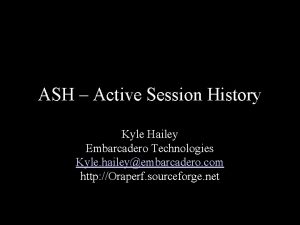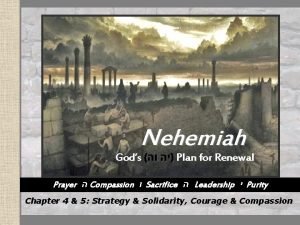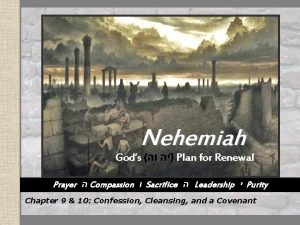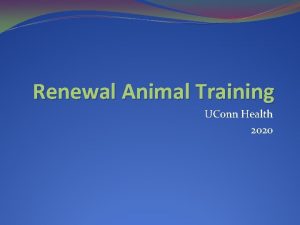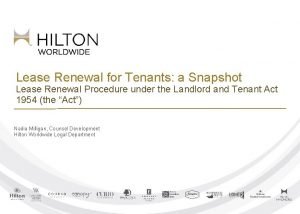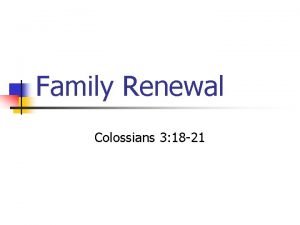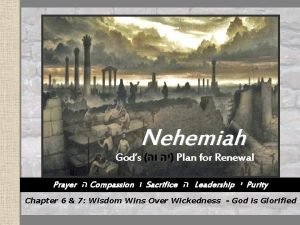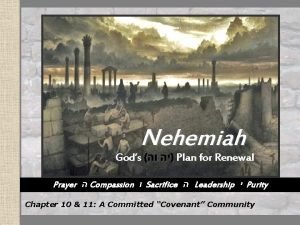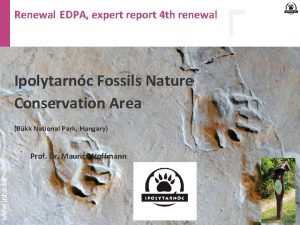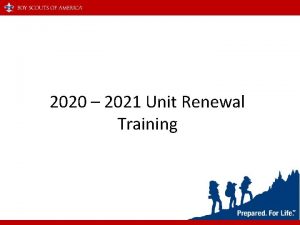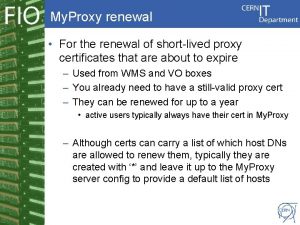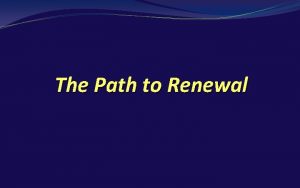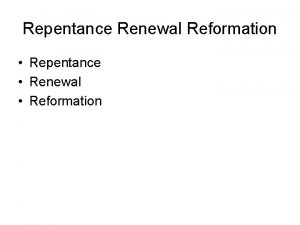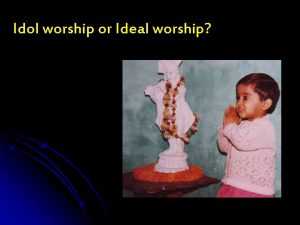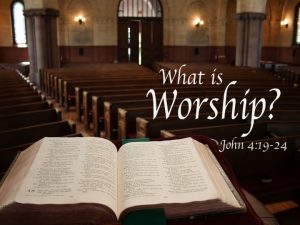Worship History for Worship Renewal Session 2 What





































- Slides: 37

Worship History for Worship Renewal, Session 2 What History Tells Us… …About Our Diet of Scripture in Worship Lester Ruth Research Professor of Christian Worship Duke Divinity School

An Overview of the Three Days • Session 1: Basic Standards • Session 2: The Diet of Scripture in Worship • Session 3: The Diet of Prayer in Worship

An Overview of the Daily Rhythm • Lecture on standards with reference to historical rooting • [a short break after about an hour] • Application exercises • Discussion and questions

What Standards from Earlier are Applicable in this Session? Aiming for a Fuller Diet of Scripture in Worship Can Accomplish Many of the Beatitudes.

II. Content: The Biblical Story of God üBlessed and wise is the worshiping congregation that remembers God’s activity as essential content of worship. üBlessed and wise is the worshiping congregation that creates some sense of this whole-Bible story in every service; blessed and wise is the worshiping congregation who creates a clear sense of this story over a reasonably short period of time. üBlessed and wise is the worshiping congregation that includes in its remembrance the breadth of God’s activity from cover to cover of the Bible, even that before the coming of Christ.

II. Content: The Biblical Story of God üBlessed and wise is the worshiping congregation whose worship content places the story of God in Christ as the key to the entire biblical content of its worship. üBlessed and wise is the worshiping congregation that makes the death and resurrection of Christ Jesus the lynchpin and cornerstone of its worship content. üBlessed and wise is the worshiping congregation that allows its worshipers to step into God’s story found in the Bible, to use that story to find the language for Christian experience.

III. Essential Actions in a Good Order a. Blessed and wise is the worshiping congregation that makes praise and thanksgiving a critical and recurring part of its services, a kind of default setting for corporate worship as well as daily discipleship. üBlessed and wise is the worshiping congregation that first remembers God’s activity and then responds appropriately. üBlessed and wise is the worshiping congregation that places passionate bursts of praise within a larger backdrop of biblical remembrance.

IV. Perspective and Commitments üBlessed and wise is the worshiping congregation that realizes its worship is not just its worship. üBlessed and wise is the worshiping congregation that expects and listens for the divine voice to directly address it today in worship. c. Blessed and wise is the worshiping congregation that assembles itself as a resurrection people by speaking edifying words to each other. d. Blessed and wise is the worshiping congregation that finds in worship its place through Christ in God’s mission in the world.

IV. Perspective and Commitments e. Blessed and wise is the worshiping congregation that anticipates our future destiny in worship. üBlessed and wise is the worshiping congregation that has worship content that both expresses the faith of the congregation and also forms the faith of the congregation. üBlessed and wise are worship leaders, whether pastoral or musical, who respect their stewardship, their sacred trust, of speaking the congregation’s faith, the Christian faith, in worship.

History Tells Us To Have More Scripture in Our Worship Why? 1. Scripture provides a common language that all Christians can recognize, accept, and agree with. ü Blessed and wise is the worshiping congregation that realizes its worship is not just its worship. 2. Scripture is the art studio for the Holy Spirit where the Spirit shapes the church in unexpected ways. ü Blessed and wise is the worshiping congregation that expects and listens for the divine voice to directly address it today in worship. 3. Scripture provides a source for our language of composition for acts of worship (prayers, songs, and sermons). ü Blessed and wise is the worshiping congregation that allows its worshipers to step into God’s story found in the Bible, to use that story to find the language for Christian experience.

History Tells Us To Have More Scripture in Our Worship Why? • More Scripture helps us tell a better, fuller story of God’s work. • And a better, fuller story • more fully honors God and • helps God’s people by “teaching, rebuking, correcting and training in righteousness. ” ü See all six standards under II. Content: Biblical Story of God. ü Blessed and wise is the worshiping congregation that first remembers God’s activity and then responds appropriately. ü Blessed and wise is the worshiping congregation that places passionate bursts of praise within a larger backdrop of biblical remembrance

Historical Example: Scripture as the Source for Composition Prayer of Humble Access (Anglican/Methodist): We do not presume to come to this your Table, O merciful Lord, trusting in our own righteousness, but in your manifold and great mercies. We are not worthy so much as to gather up the crumbs under your Table. But you are the same Lord, whose property is always to have mercy. Grant us therefore, gracious Lord, so to eat the body of your dear Son Jesus Christ, and to drink his blood, that our sinful bodies may be made clean by his body, and our souls washed through his most precious blood, and that we may evermore dwell in him, and he in us. Amen.

Historical Example: Scripture as the Source for Composition Prayer of Humble Access (Anglican/Methodist): We do not presume to come to this your Table, O merciful Lord, trusting in our own righteousness, but in your manifold and great mercies. We are not worthy so much as to gather up the crumbs under your Table. But you are the same Lord, whose property is always to have mercy. Grant us therefore, gracious Lord, so to eat the body of your dear Son Jesus Christ, and to drink his blood, that our sinful bodies may be made clean by his body, and our souls washed through his most precious blood, and that we may evermore dwell in him, and he in us. Amen. Matthew 8: 8: The centurion replied, “Lord, I do not deserve to have you come under my roof. But just say the word, and my servant will be healed. ” Mark 7: 28: “Lord, ” she replied, “even the dogs under the table eat the children’s crumbs. ”

Historical Example: Scripture as the Source for Composition Charles Wesley hymn, “Come, O Thou Traveler Unknown” Come, O you Traveler unknown, / whom still I hold, but cannot see; / my company before is gone, / and I am left alone with thee (you); / with you all night I mean to stay, / and wrestle till the break of day. In vain you struggle to get free; / I never will unloose my hold. / Are you the man that died for me? / The secret of your love unfold. / Wrestling, I will not let you go, / till I your name, your nature know. 'Tis Love!'tis Love! You died for me! / I hear you whisper in my heart! / The morning breaks, the shadows flee; / pure universal Love you art (are): / to me, to all, your mercies move; / your nature and your name is Love. Genesis 32: 22 -31

Historical Example: Scripture as the Source for Composition Prayer of preparation, Liturgy of St. James, 5 th century: Sovereign Lord Jesus Christ, O Word of God, you freely offered yourself a blameless sacrifice upon the cross to God the Father. With the coal of double nature that touched the lips of the prophet with the tongs and took away his sins, touch also the hearts of us sinners, purify us from every stain, and present us holy beside your holy altar, that we may offer you a sacrifice of praise.

Historical Example: Scripture as the Source for Composition Prayer of preparation, Liturgy of St. James, 5 th Christ has two natures: century: Human and divine Sovereign Lord Jesus Christ, O Word of God, you freely offered yourself a blameless sacrifice upon the cross to God the Father. With the coal of double nature that touched the lips of the prophet with the tongs and took away his sins, touch also the hearts of us sinners, purify us from every stain, and present us holy beside your holy altar, that we may offer you a sacrifice of praise. Isaiah 6: 6: Then one of the seraphim flew to me with a live coal in his hand, which he had taken with tongs from the altar. 7 With it he touched my mouth and said, “See, this has touched your lips; your guilt is taken away and your sin atoned for. ”

What is this? What does it represent? If you click on it, what does it do? Brief Scriptural Allusions as Hyperlinks

More Readings=More Scripture Historical Example Justin Martyr, 2 nd century, perhaps the earliest description of an order of worship: “On the day called Sunday, there is an assembling of those who live in cities or the countryside, and the memoirs of the apostles or the writings of the prophets are read as long as time permits. ”

More Readings=More Scripture Historical Example Apostolic Constitutions, a 4 th century document from Syria, describing a service in which a bishop has been ordained: “And after the reading of the Law and the Prophets, and our Epistles, and Acts, and the Gospels, let him that is ordained salute the Church, saying, ‘The grace of our Lord Jesus Christ, the love of God the Father, and the fellowship of the Holy Spirit, be with you all. ’ And let them all answer, ‘And with Your spirit. ’ And after these words let him speak to the people the words of exhortation (sermon). ”

More Readings=More Scripture Historical Example Jerusalem, 5 th century: • Easter Sunday: Psalm 65; Acts 1: 1 -14; Psalm 147; Mark 15: 4216: 8 • On the night before in the service to prepare for Easter: Psalm 118; Genesis 1: 1 -3: 24; Genesis 22: 1 -18; Exodus 12: 1 -24; Jonah 1: 1 -4: 11; Exodus 14: 24 -15: 21; Isaiah 60: 1 -13; Job 38: 2 -28; 2 Kings 2: 1 -22; Jeremiah 31: 31 -34; Joshua 1: 1 -9; Ezekiel 37: 1 -14; Daniel 3: 1 -23; Psalm 65; I Corinthians 15: 1 -11; Psalm 30; Matthew 28: 1 -20

What are the Goals in a Fuller Diet of Scripture in Worship? üBlessed and wise is the worshiping congregation that creates some sense of this whole-Bible story in every service; blessed and wise is the worshiping congregation who creates a clear sense of this story over a reasonably short period of time. üBlessed and wise is the worshiping congregation that includes in its remembrance the breadth of God’s activity from cover to cover of the Bible, even that before the coming of Christ.

What is a Full Scriptural Story? The Triune God’s activity in The Triune God’s activity before the Incarnation and present activity future activity the Incarnation: after the Birth: through Jesus Christ at the return of Creation; Jesus’ life, ministry, by the Holy Spirit Jesus Christ Pre-Abraham; death, resurrection, Post-Abraham Ascension, and On earth and in heaven outpouring of the Holy Within and outside the church Spirit Within and outside an individual Personal and Cosmic dimensions

How Do We Get a Fuller Diet of Scripture? 1) Have more Scripture readings in a service from across the entire Bible a) Cultivate the ability of the people to hold the whole Bible together as a single story with Jesus Christ as the major plot line A historical example from 4 th century Jerusalem: the bishop prepares candidates for baptism, teaching them in the weeks ahead of baptism: “During the forty days he goes through the whole Bible, beginning with Genesis. First he relates the literal meaning of each passage, and then he interprets its spiritual meaning (how it relates to Jesus Christ and being his disciple). ” b) Follow an annual calendar that provides you regimen to read a breadth of Scripture. (See the handout

How Do We Get a Fuller Diet of Scripture? 2) Use sermons for children (read from picture Bible or dramatize at the moment) 2) Use adult dramatization 3) Use images of Bible stories as part of arrangement for song slides 5) Make more references to stories in Scripture in sermons 6) Use a whole passage as some kind of act of worship: a call to worship, a prayer of confession, an assurance of pardon, an affirmation of faith.

How Do We Get a Fuller Diet of Scripture? 7) Choose songs that are based on Scripture. 8) Find or construct prayers that are filled with Scripture and with references to biblical stories and themes. 9) Utilize the spoken transitions between songs or between other acts of worship.

Application Exercises Let us work on some skills which help facilitate having a fuller diet of Scripture in worship.

Exercise: Skill 1: Constructing a Commemorative Prayer • Historical example, the Collect for Purity: Almighty God, to you all hearts are open, all desires known, and from you no secrets are hidden. Cleanse thoughts of our hearts by the inspiration of your Holy Spirit, that we may perfectly love you, and worthily magnify your holy name, through Christ our Lord. Amen. • Notice the structure of the prayer: 1) Name God; 2) Remember something God has done or something God is; 3) Ask for something in light of what God has done or who God is; 4) State the desired results of God answering the prayer; 5) Pray through Jesus Christ.

Exercise: Skill 1: Constructing a Commemorative Prayer • Notice the structure of the prayer: 1) Name God; 2) Remember something God has done or something God is; 3) Ask for something in light of what God has done or who God is; 4) State the desired results of God answering the prayer; 5) Pray through Jesus Christ. • Prompt: Imagine you want to construct a closing prayer for a service whose theme was “God calls us to mission” and whose main scripture was Acts 13: 2 (While they were worshiping the Lord and fasting, the Holy Spirit said, "Set apart for me Barnabas and Saul for the work to which I have called them. ”). What could be said in that closing prayer based on the structure above?

Exercise: Skill 1: Which One is a Commemorative Scriptural Prayer? Option 1 Option 2 Lord God, by your Spirit you order all things in your church, distribute gifts among all your people, and call us to share in his witness to the world. Send your Holy Spirit so that those who have been called by you may be empowered to speak the Gospel with boldness. We ask for this blessing in the name of your Son, Jesus Christ. Amen. Lord God, we earnestly desire more of your Spirit. We hunger and thirst for you, the living God. Do not let us leave this place without the Holy Spirit’s touch. Father, we need your Spirit to fulfill the ministries to which you have called us. We ask for this blessing in the name of your Son, Jesus Christ. Amen.

Exercise: Skill 2: Choosing Additional Scriptures • It is useful to think about the possible relationships between Scriptures from across the whole Bible in order to think about choosing passages beyond the main one for a service. • There are lots of ways that Scriptures can relate to each other, including: Ø A scripture can anticipate another. Ø A scripture can provide the foundation or rooting for another. Ø A scripture can establish the context or background for another. Ø A scripture can state the reason for something discussed in another scripture. Ø A scripture can provide a positive or negative example for something discussed in another scripture. Ø A scripture can reinforce, extend, or expand something seen in another scripture. Ø A scripture can show the fulfillment of another scripture.

Exercise: Skill 2: Choosing Additional Scriptures • Imagine Philippians 2: 1 -13 as the preaching text for a Sunday. • Which of the following would be good choices to coordinate with the Philippians 2? • • • Exodus 7: 1 -7 Isaiah 45: 22 -23 I Sam. 16: 10 -13 Colossians 1: 15 -20 Matthew 21: 23 -27 Matthew 20: 20 -28

Exercise: Skill 3: Creative Connections between Stories and Songs • Background: When the main Scripture for a service is a biblical story, it is a useful skill to be able to go beyond obvious connections to choose songs for that service. It is a useful skill to exercise creative imagination. • 2 kinds of creative imagination: 1) Work from song to story: When the lyrics of a song in mind, imagine which biblical character at what time could sing this song? Upon whose lips does this song sound appropriate? 2) Work from story to song: Imagine that a character in a Bible story knew your church’s collection of favorite songs? What song from your church could you imagine the biblical character singing?

Exercise: Skill 3 a: Creative Connections Between Stories and Songs • Which biblical character at what time could you imagine singing the following song, “Who You Say I am”? • Verse 1: Who am I that the highest King / Would welcome me / I was lost but He brought me in / Oh His love for me • Chorus 1: Who the Son sets free / Oh is free indeed / I'm a child of God / Yes I am • Verse 2: Free at last / He has ransomed me / His grace runs deep / While I was a slave to sin / Jesus died for me / Yes He died for me • Chorus 2: In my Father's house / There's a place for me / I'm a child of God / Yes I am • Bridge: I am chosen not forsaken / I am who You say I am / You are for me not against me / I am who You say I am • Tag: (Oh) (Yes) I am who You say I am

Exercise: Skill 3 a: Creative Connections Between Stories and Songs • Which biblical character at what time could you imagine singing the following song, “ 10000 Reasons”? • Chorus: Bless the Lord O my soul / Worship His holy • • name / Sing like never before / O my soul / I'll worship Your holy name Verse 1: The sun comes up it's a new day dawning / It's time to sing Your song again / Whatever may pass and whatever lies before me / Let me be singing when the evening comes Verse 2: You're rich in love and You're slow to anger / Your name is great and Your heart is kind / For all Your goodness I will keep on singing / Ten thousand reasons for my heart to find Verse 3: And on that day when my strength is failing / The end draws near and my time has come / Still my soul will sing Your praise unending / Ten thousand years and then forevermore Ending: Worship Your holy name / Lord I'll worship Your holy name

Exercise: Skill 3 b Creative Connections Between Stories and Songs • Prompt: Assuming that the apostle Peter knew your congregation’s favorite songs, what song could you imagine Peter singing after he had just seen the Holy Spirit poured out upon the centurion Cornelius (Acts 10) and his household?

Exercise: Skill 5: Spoken Transitions Based on Scripture • Prompt: Imagine that these two songs (“Who You Say I Am” and “ 10000 Reasons”) were the first two songs in your congregation’s worship and that you had worked out the musical aspects of flowing between the songs. Based on the Scripture characters identified in the exercise above, how might you create a brief spoken transition between two songs? • Prompt: Imagine that the song identified in connection with Peter and Cornelius was a song in your congregation’s order of worship, how might you create a brief spoken transition to lead from this song to the next?

Questions and Answer Time • Where is the strength in our church’s use of Scripture? God’s activity before Christ? God’s activity during Christ’s life and ministry? God’s activity now? God’s activity in the future? • Which of the ideas for including more scriptural content in worship is the most useful for the churches you know? • What are your questions or comments about the standards? (Please ask me later if there is no time now. )
 Active session history
Active session history Active session history
Active session history Iso 22301 utbildning
Iso 22301 utbildning Typiska novell drag
Typiska novell drag Nationell inriktning för artificiell intelligens
Nationell inriktning för artificiell intelligens Vad står k.r.å.k.a.n för
Vad står k.r.å.k.a.n för Shingelfrisyren
Shingelfrisyren En lathund för arbete med kontinuitetshantering
En lathund för arbete med kontinuitetshantering Särskild löneskatt för pensionskostnader
Särskild löneskatt för pensionskostnader Tidbok
Tidbok A gastrica
A gastrica Vad är densitet
Vad är densitet Datorkunskap för nybörjare
Datorkunskap för nybörjare Tack för att ni lyssnade bild
Tack för att ni lyssnade bild Att skriva en debattartikel
Att skriva en debattartikel Magnetsjukhus
Magnetsjukhus Nyckelkompetenser för livslångt lärande
Nyckelkompetenser för livslångt lärande Påbyggnader för flakfordon
Påbyggnader för flakfordon Arkimedes princip formel
Arkimedes princip formel Publik sektor
Publik sektor Jag har nigit för nymånens skära text
Jag har nigit för nymånens skära text Presentera för publik crossboss
Presentera för publik crossboss Jiddisch
Jiddisch Vem räknas som jude
Vem räknas som jude Klassificeringsstruktur för kommunala verksamheter
Klassificeringsstruktur för kommunala verksamheter Fimbrietratt
Fimbrietratt Claes martinsson
Claes martinsson Centrum för kunskap och säkerhet
Centrum för kunskap och säkerhet Programskede byggprocessen
Programskede byggprocessen Bra mat för unga idrottare
Bra mat för unga idrottare Verktyg för automatisering av utbetalningar
Verktyg för automatisering av utbetalningar Rutin för avvikelsehantering
Rutin för avvikelsehantering Smärtskolan kunskap för livet
Smärtskolan kunskap för livet Ministerstyre för och nackdelar
Ministerstyre för och nackdelar Tack för att ni har lyssnat
Tack för att ni har lyssnat Referat mall
Referat mall Redogör för vad psykologi är
Redogör för vad psykologi är Stål för stötfångarsystem
Stål för stötfångarsystem

